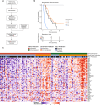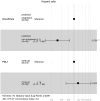Multidimensional biomarker predicts disease control in response to immunotherapy in recurrent or metastatic head and neck squamous-cell carcinoma
- PMID: 37552307
- PMCID: PMC10590294
- DOI: 10.1007/s00432-023-05205-z
Multidimensional biomarker predicts disease control in response to immunotherapy in recurrent or metastatic head and neck squamous-cell carcinoma
Abstract
Purpose: Anti-PD-1 therapy provides clinical benefit in 40-50% of patients with relapsed and/or metastatic head and neck squamous cell carcinoma (RM-HNSCC). Selection of anti- PD-1 therapy is typically based on patient PD-L1 immunohistochemistry (IHC) which has low specificity for predicting disease control. Therefore, there is a critical need for a clinical biomarker that will predict clinical benefit to anti-PD-1 treatment with high specificity.
Methods: Clinical treatment and outcomes data for 103 RM-HNSCC patients were paired with RNA-sequencing data from formalin-fixed patient samples. Using logistic regression methods, we developed a novel biomarker classifier based on expression patterns in the tumor immune microenvironment to predict disease control with monotherapy PD-1 inhibitors (pembrolizumab and nivolumab). The performance of the biomarker was internally validated using out-of-bag methods.
Results: The biomarker significantly predicted disease control (65% in predicted non-progressors vs. 17% in predicted progressors, p < 0.001) and was significantly correlated with overall survival (OS; p = 0.004). In addition, the biomarker outperformed PD-L1 IHC across numerous metrics including sensitivity (0.79 vs 0.64, respectively; p = 0.005) and specificity (0.70 vs 0.61, respectively; p = 0.009).
Conclusion: This novel assay uses tumor immune microenvironment expression data to predict disease control and OS with high sensitivity and specificity in patients with RM-HNSCC treated with anti-PD-1 monotherapy.
Keywords: Biomarker; HNSCC; Immune checkpoint inhibitors; PD-1; PD-L1; Pembrolizumab.
© 2023. The Author(s).
Conflict of interest statement
KCF, JE, IS, JH, RLW, NAL, ZSB, JB, DNM, JIG, and EJD are employed, have stock interests, and/or a financial relationship with Cofactor Genomics, Inc., maker of the OncoPrism test.
Figures




References
-
- Brockstein BE, Vokes EE (2023) Treatment of metastatic and recurrent head and neck cancer. In Post TW, Posner MR, and Shah S (Eds.), UpToDate, Waltham, MA. Available from https://www.uptodate.com/contents/treatment-of-metastatic-and-recurrent-.... Accessed 12 May 2023
-
- Burtness B, Harrington KJ, Greil R et al (2019) Pembrolizumab alone or with chemotherapy versus cetuximab with chemotherapy for recurrent or metastatic squamous cell carcinoma of the head and neck (KEYNOTE-048): a randomised, open-label, phase 3 study. Lancet 394:1915–1928. 10.1016/S0140-6736(19)32591-7 - PubMed
-
- Cai C, Chernock RD, Pittman ME et al (2014) Keratinizing-type squamous cell carcinoma of the oropharynx: p16 overexpression is associated with positive high-risk HPV status and improved survival. Am J Surg Pathol 38:809–815. 10.1097/PAS.0000000000000183 - PubMed
-
- Chow LQM (2020) Head and neck cancer. N Engl J Med 382:60–72. 10.1056/NEJMra1715715 - PubMed
LinkOut - more resources
Full Text Sources
Research Materials

